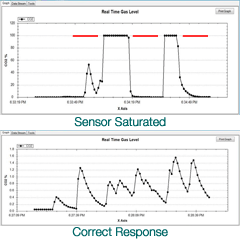
Experimenting with the SprintIR 60% CO2 Sensor

A client was having trouble getting correct readings with our SprintIR 60% CO2 sensor. They were attempting to use the sensor to read exhaled carbon dioxide in an application similar to capnography, but were getting unexpected results.

CO2Meter Duplicates the Results
Fortunately, we were able to duplicate the result in our lab. In the first plot, we found that we could saturate the sensor by blowing hard on it about 1 inch from the sensor membrane surface. In the second plot, we blew on the sensor from a distance of about 4 inches and achieved more accurate results.
With some experimentation, we found that we cold saturate the sensor at will, and then desaturate the sensor by sucking very close to the surface. The hot breath was hazing the optics. Conversely, by sucking the air near the membrane surface we were changing the pressure so that the condensate evaporated and the sensor began operating correctly virtually instantaneously. The same effect can be found by exhaling close to a mirror.
Although we had solved the mystery, we recommended the client use a vacuum pump and hydrophobic filter setup similar to the one we've tested for capnography to achieve the most accurate results.
Sensor Experts
For more information regarding capnography or sensors, trust the experts at CO2Meter to answer any questions you may have. Contact us online or call 877.678.4259 today.







